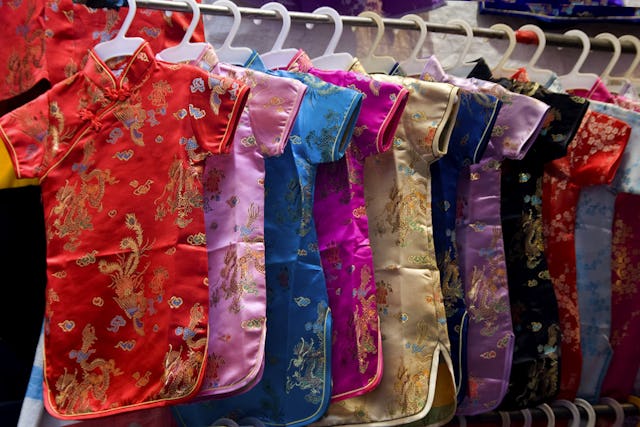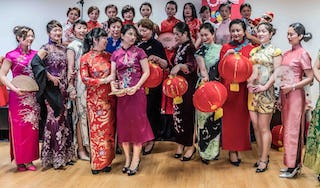This Chinese tradition goes all the way back to the Northern and Southern dynasties (420–589 AD). In the Song Dynasty (960–1279 AD), everyone would show off their new clothing as they visited friends on New Year’s Day.
In the Republican period (1912–1949), beautiful new clothes were needed as the youth paid their respects to the elders. It’s a part of Spring Festival celebrations, just like the New Year’s Eve reunion dinner. You might be able to guess why.
Significance of new clothes
The Spring Festival is a time of change and new beginnings. Practically every activity during the Spring Festival has the purpose of removing the old and welcoming the new. Forget about the misfortunes and be ready for good luck. In addition, new clothes are auspicious and can protect you from evil spirits.
Like the New Year couplets and other decorations, new clothes also add to the festivity. In the past, China was an agrarian society. There was only 1 harvest per year in the north and 2-3 in the south. Throughout the entire year, people scrimped and saved.
But during Chinese New Year, people can finally splurge and treat themselves. This side of new clothes is a little lost on the younger generations. But it’s a sign that the current standard of living is higher than before. Still, it’s important to be aware of the historical significance.
How and when?
You can buy yourself new clothes. But often, they will be given as gifts from the family. Because it’s a sign of a fresh start, it’s best to wear your new attire on New Year’s Day.
What should you wear?
There actually aren’t any special requirements as to what kind of new clothing. In ancient China, people would follow the fashion trends of that time. There’s nothing wrong with you doing the same as well.
But if you want to have more of a traditional flare, there are some styles you can choose from. Most traditional-wear still popular today are from the Qing dynasty.
Tang Suit
A Tang suit (唐装 / táng zhuāng) used to refer to dress from the Tang dynasty. But the “new” Tang suit is a jacket that combines the Man riding jacket (Qing dynasty) and the Western suit.

If you’re a fan of Chinese martial arts, you might have seen this type of clothing in movies. Jackie Chan especially seems to like wearing them. The Tang suit was also the “dress code” for the 2001 APEC meeting.
It has an upturned collar and straight lapels. The suit features traditional Chinese knots (frog buttons). The material is usually brocade, a luxury fabric in ancient times.
Originally, it was seamless between the body and sleeves. This allowed for comfortable movement, but the looseness doesn’t quite fit modern aesthetics.
Most Tang suits nowadays are modified and tailored. Many have auspicious symbols and words embroidered into the shirt.
Qipao
The qipao (旗袍 / qí páo) entered mainstream Chinese culture during the Qing dynasty. But the modern styles we know today are very different from how it was originally. It began as a conservative dress with straight and loose cuts. Intricate designs were embroidered into the fabric. Through colonization, the qipao became westernized.

Starting in the mid-1800s until now, the changes go back and forth. Styles swing between long and short, tight and loose. Nowadays, the qipao is usually very tight-fitting (it’s recommended to get the dress custom-made). Openings can start as high up as the thigh.
However, modern styles still preserve the stiff straight collar and frog buttons. Popular embroidered designs include flowers, birds and phoenixes.
Cheongsam
The term “cheongsam” (长衫 / cháng shān) is usually used by Westerners to refer to women’s qipao. However, it literally means “long shirt/dress.” It is loose-fitting and usually worn by men now.
It is a modified version of Qing dynasty clothing and was formal wear during the 1900s. The cut for the sideways lapel symbolizes wealth and prosperity. The length of the cheongsam also represents status, since longer clothing is unsuitable for physical labor. In the Republican era, it was the clothing of educated scholars.
Hanfu
“Hanfu” (汉服 / hàn fú) translates literally to “clothing of the Han ethnicity.” It encompasses traditional clothing up until the Qing dynasty. This means too many types and variations to count.
Generally, a hanfu outfit includes a shirt and a skirt. The shirt has crossed lapels and the sleeves are long and wide. The skirt is long and sometimes starts above the bosom.
Tang dynasty hanfu influenced the Japanese kimono, while the Ming dynasty influenced the Korean hanbok.
The elegant cuts and fresh colors will bring something unique to your wardrobe. There are also modern versions, including shorter skirts and more Western elements.
If you’re looking for something dressier and eye-catching, hanfu is the answer.
Shoes
If you’re looking for some stylish kicks, you’re in luck, as many major brands have started releasing Chinese New Year themed shoes leading up to the holiday.
However, be careful with your timing, as some Chinese, especially Cantonese, are superstitious about buying shoes during the Chinese New Year holiday. So make sure you grab a pair before the festivities start.
Also, you should never give shoes as a gift, since in Chinese the word for shoes 鞋 (xié) sounds like the word for “evil” or “bad luck” 邪 (xié). For more on what you should and shouldn’t do throughout the holiday celebrations check out our list of taboos.
Accessories
In ancient times, men were not allowed to go without a headdress. That’s not necessary anymore though. You can choose whatever handsome hairstyle you’d like.
There are fancier choices for women. Using chopsticks as hair accessories is a misconception. Instead, ornate wands are used. They usually taper off to an intricate design, inlaid with jewels, and trinkets hang off the end.
If you wear a hanfu, you can also add a pendant to the waistband.
Some things to keep in mind
When buying clothes for Chinese New Year, go for red. This is the best color for the occasion. Stay away from black and white, as they are unlucky and negative (for more unlucky things to watch out for, check out our list of the top 10 taboos).
Also remember that new clothes are a set part of Spring Festival celebrations, but it’s not necessary to wear a full traditional gear to a dinner party.
The Tang suit is the most popular choice. Qipaos are also accepted, although the nature of the dress isn’t the best for the winter season. The hanfu (and cheongsam) is regaining popularity, but is still not as widely accepted.
Be careful of cultural appropriation when wearing traditional clothing of another culture. Many native Chinese are okay with it. In fact, they’ll be delighted if they see foreigners in traditional clothing.
However, many Chinese expats in other countries find it uncomfortable. If a Chinese friend is the host or guest of the party, it’ll never hurt to ask them how they feel about it.
Other than that, welcome the coming year with a fresh new look and a smile!
